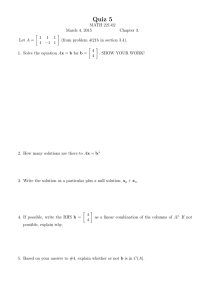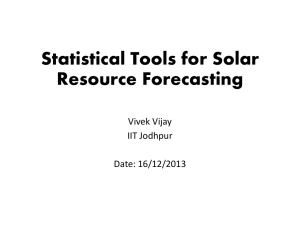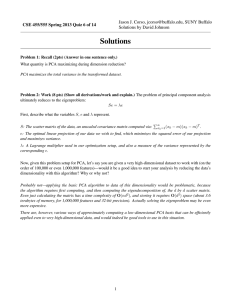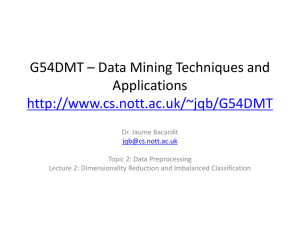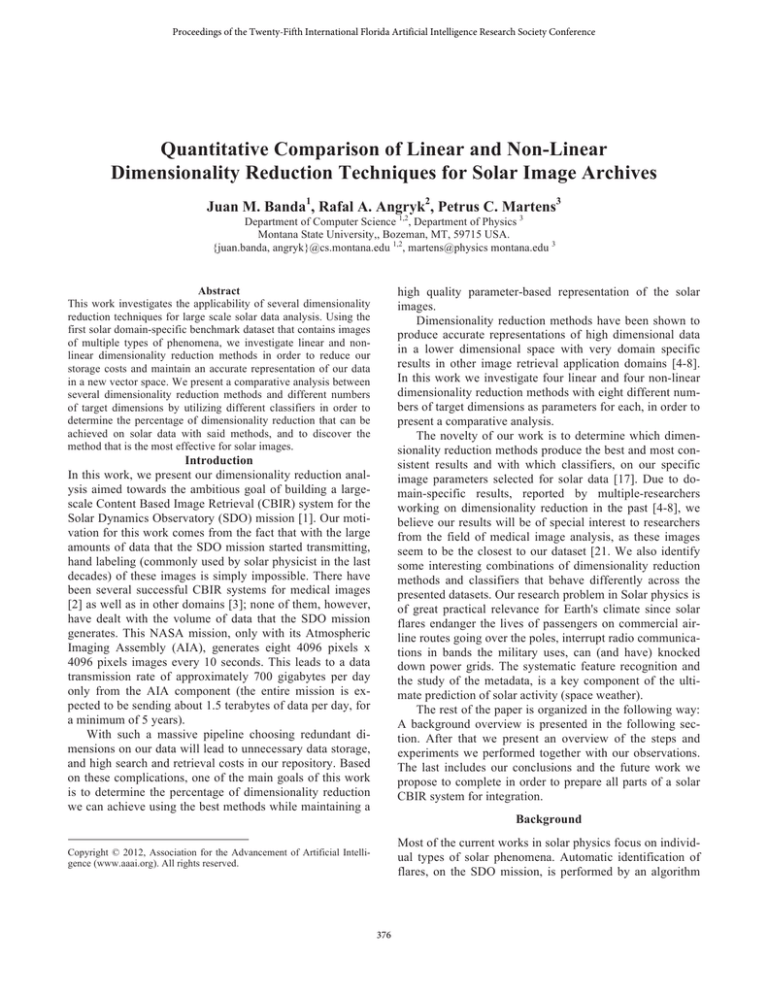
Proceedings of the Twenty-Fifth International Florida Artificial Intelligence Research Society Conference
Quantitative Comparison of Linear and Non-Linear
Dimensionality Reduction Techniques for Solar Image Archives
Juan M. Banda1, Rafal A. Angryk2, Petrus C. Martens3
Department of Computer Science 1,2, Department of Physics 3
Montana State University,, Bozeman, MT, 59715 USA.
{juan.banda, angryk}@cs.montana.edu 1,2, martens@physics montana.edu 3
high quality parameter-based representation of the solar
images.
Dimensionality reduction methods have been shown to
produce accurate representations of high dimensional data
in a lower dimensional space with very domain specific
results in other image retrieval application domains [4-8].
In this work we investigate four linear and four non-linear
dimensionality reduction methods with eight different numbers of target dimensions as parameters for each, in order to
present a comparative analysis.
The novelty of our work is to determine which dimensionality reduction methods produce the best and most consistent results and with which classifiers, on our specific
image parameters selected for solar data [17]. Due to domain-specific results, reported by multiple-researchers
working on dimensionality reduction in the past [4-8], we
believe our results will be of special interest to researchers
from the field of medical image analysis, as these images
seem to be the closest to our dataset [21. We also identify
some interesting combinations of dimensionality reduction
methods and classifiers that behave differently across the
presented datasets. Our research problem in Solar physics is
of great practical relevance for Earth's climate since solar
flares endanger the lives of passengers on commercial airline routes going over the poles, interrupt radio communications in bands the military uses, can (and have) knocked
down power grids. The systematic feature recognition and
the study of the metadata, is a key component of the ultimate prediction of solar activity (space weather).
The rest of the paper is organized in the following way:
A background overview is presented in the following section. After that we present an overview of the steps and
experiments we performed together with our observations.
The last includes our conclusions and the future work we
propose to complete in order to prepare all parts of a solar
CBIR system for integration.
Abstract
This work investigates the applicability of several dimensionality
reduction techniques for large scale solar data analysis. Using the
first solar domain-specific benchmark dataset that contains images
of multiple types of phenomena, we investigate linear and nonlinear dimensionality reduction methods in order to reduce our
storage costs and maintain an accurate representation of our data
in a new vector space. We present a comparative analysis between
several dimensionality reduction methods and different numbers
of target dimensions by utilizing different classifiers in order to
determine the percentage of dimensionality reduction that can be
achieved on solar data with said methods, and to discover the
method that is the most effective for solar images.
Introduction
In this work, we present our dimensionality reduction analysis aimed towards the ambitious goal of building a largescale Content Based Image Retrieval (CBIR) system for the
Solar Dynamics Observatory (SDO) mission [1]. Our motivation for this work comes from the fact that with the large
amounts of data that the SDO mission started transmitting,
hand labeling (commonly used by solar physicist in the last
decades) of these images is simply impossible. There have
been several successful CBIR systems for medical images
[2] as well as in other domains [3]; none of them, however,
have dealt with the volume of data that the SDO mission
generates. This NASA mission, only with its Atmospheric
Imaging Assembly (AIA), generates eight 4096 pixels x
4096 pixels images every 10 seconds. This leads to a data
transmission rate of approximately 700 gigabytes per day
only from the AIA component (the entire mission is expected to be sending about 1.5 terabytes of data per day, for
a minimum of 5 years).
With such a massive pipeline choosing redundant dimensions on our data will lead to unnecessary data storage,
and high search and retrieval costs in our repository. Based
on these complications, one of the main goals of this work
is to determine the percentage of dimensionality reduction
we can achieve using the best methods while maintaining a
Background
Most of the current works in solar physics focus on individual types of solar phenomena. Automatic identification of
flares, on the SDO mission, is performed by an algorithm
Copyright © 2012, Association for the Advancement of Artificial Intelligence (www.aaai.org). All rights reserved.
376
created by Christe et al. [10] which works well for noisy
and background-affected light curves. This approach will
allow detection of simultaneous flares in different active
regions. Filament detection for the SDO mission will be
provided by the “Advanced Automated Filament Detection
and Characterization Code” [11]. As for the coronal jet detection and parameter determination algorithms, these SDO
methods are described in detail in [12]. In order to detect
active regions, the SDO pipeline will use the Spatial Possibilistic Clustering Algorithm (SPoCA). Not until recently
Lamb et al. [15] discussed creating an example based Image
Retrieval System for the TRACE repository. This is the
only attempt, that we are aware of, that involves trying to
find a variety of phenomena, with expectation of building a
large-scale CBIR system for solar physicists.
Some comparisons between dimensionality reduction
methods for image retrieval have been performed in the
past [4-8], these works constantly encounter the fact that
results are very domain-specific and that performance of the
non-linear versus linear dimensionality reduction methods
has been shown to be dependent of the nature of the dataset
(natural vs. artificial) [16]. We expect to find interesting
properties of our dataset with the application of different
types of dimensionality reduction methods.
Based on the 8 by 8 grid segmentation and our ten image parameters per each cell, our current benchmark dataset
has 640 dimensions per image. Since the SDO images are 4
times bigger, they will produce a total of 10,240 dimensions
per image and at a cost of 540 kilobytes per dimension (per
day) this will get very expensive to store and search.
For comparative purposes we utilized subsets (matching
the quantity of 1,600 images in eight equally balanced classes) of the following datasets: INDECS [44] and ImageCLEFmed [43] 2005. The INDECS dataset provides
office images that are very dissimilar from each other and
from our own type of images. On the other hand, the ImageCLEFmed [43] 2005 dataset provides several classes of
medical images that somehow resemble ours due to the fact
that both images are greyscale and feature fuzzy objects
with just a few well defined persistent visual characteristics.
Image parameters (a k.a Image Features)
Based on our literature review, we decided that we would
use some of the most popular image parameters (as called
in the field of Solar physics, but referred to as image features in computer vision areas) used in different fields such
as medical images, text recognition, natural scene images
and traffic images [2, 13, 20-22]. Since the usefulness of all
these image parameters has shown to be very domain dependent, we selected these parameters, based on the evaluation published in [11, 17 and 19] that covered both supervised and unsupervised attribute evaluation methods and
techniques.
The ten image parameters that we used for this work
are: Entropy, Fractal dimension, Mean, Skewness, Kurtosis,
Relative Smoothness, Standard Deviation, Tamura Contrast, Tamura Directionality and Uniformity.
Benchmark Datasets
The dataset, first introduced in [17], consists of 1,600 images divided in 8 equally balanced classes representing 8
types of different solar phenomena (each having 200 images). All of our images are grayscale and 1,024 by 1,024
pixels. The solar phenomenons included in the dataset are:
Active Region, Coronal Jet, Emerging Flux, Filament, Filament Activation, Filament Eruption, Flare and Oscillation.
The benchmark dataset both in its original and preprocessed format is freely available to the public via Montana State University’s server [18]. Because of promising
results obtained during earlier investigations [15, 19], we
choose to segment our images using an 8 by 8 grid for our
image parameter extraction (as seen on fig. 1).
Dimensionality Reduction Methods
Based on our literature review, we decided to utilize four
different linear and four non-linear dimensionality reduction methods. As shown by others [5, 8, 16] linear dimensionality reduction methods have proved to perform better
than non-linear methods in most artificial datasets and some
natural datasets. However all these results have been very
domain dependent. Classical methods like PCA and SVD
are widely used as benchmarks to provide a comparison
versus the newer non-linear methods. We selected eight
different methods based on (1) their popularity in the literature, (2) the availability of a mapping function or method to
map new unseen data points into the new dimensional
space, (3) computational expense, and (4) the particular
properties of some methods such as the preservation of local properties between the data and the type of distances
between the data points (e.g. Euclidean versus geodesic).
Due to the limited space available for this publication,
we omit the full descriptions of these methods, however,
they can be found here [45] in the extended version of this
paper.
Figure 1. Grid based segmentation applied to our solar dataset prior to parameter extraction (a). (b) and (c) show
samples of images of the other datasets tested.
377
Linear dimensionality reduction methods
•
•
•
•
For the non-linear methods that utilize neighborhood
graphs we used between 6 and 12 as the number of nearest
neighbors, and presented the best results since they varied
by less than 0.001% of classification accuracy we decided
to omit them from our presentation in this paper.
Principal Component Analysis (PCA) [23]
Singular Value Decomposition (SVD) [24]
Factor Analysis (FA) [26]
Locality Preserving Projections (LPP) [25]
Mapping functions
Since we are planning on applying the best dimensionality
reduction method on new data we will be receiving for the
next five to ten years, we decided to simulate this scenario
with our benchmark dataset.
In our experiments we performed the dimensionality
reduction methods on 67% of our data and then map ‘new’
data points (the remaining 33% of our data) into the resulting low-dimensional representation that each dimensionality reduction method produces. We then feed these dimensionality reduced data points respectively as training and
test sets to our classification algorithms.
For linear dimensionality reduction methods, the mapping of new data points is very straight forward since, for
example for PCA and SVD you only have to multiply the
new data points with the linear mapping matrix V.
As for non-linear dimensionality reduction methods, the
mapping of new data points is not as straight forward. For
Kernel PCA it is somewhat similar to the original PCA, but
requires some additional kernel function computations as
presented in [34]. For Isomaps, LLE, and LE we used kernel methods that have been presented in [35] and alternative
approaches as shown in [36-40]
Non-linear dimensionality reduction methods
•
•
•
•
Isomap [28]
Kernel PCA [27]
Laplacian Eigenmaps (Laplacian) [31]
Locally-Linear Embedding (LLE) [30]
Classification algorithms
In order to help us determine the number of dimensions that
we can reduce from our benchmark datasets, we decided to
use classifiers for our comparative analysis of the performance of these dimensionality reduction methods on our
benchmark datasets.
We selected Naïve Bayes (NB) as our linear classifier,
Support Vector Machines (SVM) with a non-linear kernel
function as our non-linear classifier, and C4.5 as a decision
tree classifier. We opted to use these classification methods
based on our literature review and previous research work
[15, 17, 19 and 21]. As a brief summary, SVM has shown
results that constantly depend on the nature of the dataset it
is being applied to. C4.5 is also widely used in different
applications and on research works, providing domainspecific results. NB due to its fast training and low computational cost is very popular and surprisingly accurate in
many domains. A more detailed explanation behind our
selection of these classification algorithms is presented in
[17 and 21].
Conclusions and Future Work
Fig. 2 shows classification accuracy of our three selected
classifiers on the original non-reduced data sets and the 64
dimensionally reduced experiments (from Tab. 1, it can be
seen that we investigated 8 sets of dimensions for each of
the 8 dimensionality reduction methods). Figure 2 presents
the original data (first row), then the 4 linear dimensionality
reduction methods followed by the 4 non-linear.
The first observation we can make is that our image parameters produced very bad results for a dataset (INDECS)
that contains images very different from our own dataset
(Solar [18]) and the other that contains images similar to
ours (ImageCLEFMed). This clearly shows that using the
right image parameters for a specific type of images is very
important. We can also observe that SVM’s produced most
of the higher classification percentages for our Solar dataset
and the ImageCLEFMed. To better show these occurrences
we included bold dotted lines across fig. 2 for the highest
classification results (SVM’s) of the original datasets. An
interesting observation is that some combinations of classifiers and dimensionality reduction methods (e.g. LLE and
C4.5) actually produced better results than our original nonreduced dataset (for C4.5). We can also see a few of these
combinations that produced very bad results (C4.5 and Factor Analysis) and others that dramatically drop in accuracy
(KernelPCA for all classifiers),
Approach and Experiments
All classification comparisons were performed in Weka
3.6.1 [32]. We utilized the default settings for all classifiers
since we are performing a comparative analysis. We selected 67% of our data as the training set and an ‘unseen’ 33%
test set for evaluation. All dimensionality reduction methods were investigated using the Matlab Tool box for dimensionality reduction [33] and the standard Matlab functions.
For ‘optimal’ dimensionality estimation we decided to
utilize the number of dimensions returned by standard PCA
as presented in [41] and SVD’s setting up a variance
threshold between 96 and 99%. Tab. 1 presents these numbers of dimensions for all three datasets utilized.
PCA Variance
97%
98%
SVD Variance
97%
98%
Dataset
96
%
Solar [18]
42
46
51
58
58
74
99
143
INDECS [44]
94
106
121
143
215
239
270
319
79
89
103
126
193
218
253
307
1
2
3
4
5
6
7
8
ImageCLEF
med [43]
Experiment
Label
99%
96%
99%
Table 1. Number of dimensions selected for each dataset
378
Figure 2. Classification accuracy of all dimensionality reduction methods for all 8 experiments per method for all datasets tested
The tree-based classifier performs very poorly with the
Factor Analysis (FA) generated space by making very bad
splitting decisions. Since C4.5 is a greedy algorithm (it
never re-evaluates choice of attributes) it results in the accuracy dropping to 12%, which is equal to random labeling
assignment. We can conclude that if you are using FA for
379
your dimensionality reduction, it might be a good idea to
stay away from decision tree based classifiers.
After looking at the drops in figure 2, KernelPCA
showed very dramatic decrease in accuracy for a higher
number of components. We attribute this drop to the partitioned space by kernel PCA, in a low number of dimensions
this method achieves very good representation of our original data space, however when more dimensions are used,
the method just produces more noise for the classifiers and
damages their performance considerably.
Laplacian Eigenmaps (Laplacian) offer the most consistent results we have seen when applied to our Solar dataset. For all classifiers this dimensionality reduction method provides over 80% accuracy and for SVM it stays over
90% for the most part of fig. 2. The difference between the
accuracy of each method is on average less than 10%, this
supports the claim of how consistent this data representation is.
As we have mentioned in this paper, we are focusing on
achieving dimensionality reduction in order to reduce storage costs, and if we have to sacrifice less than 3% in accuracy (especially at the 90% level) for more than 30% in
storage, we are willing to take the hit in accuracy.
As we can see from the first half of fig. 2, the linear
methods performed very consistently when the number of
components increases. We can say that SVM is the most
consistent and best performing classification method we
utilized. Most of the non-linear dimensionality methods
allow the classifiers to perform more consistently between
them (bottom half of fig. 2). Even when doing badly, the
classifiers accuracy stays on average within 10% of each
other. Making these new dimensional spaces better suited
for classification (on average) than the linear ones. We also
show that our way of selecting the number of components,
provides results on both sides of the fence for non-linear
methods.
Out of all of the non-linear dimensionality reduction
methods presented on figure 2, Laplacian and LLE are the
only ones to show consistent classification accuracy improvement when compared to linear methods (with the exception of LPP). We theorize that since Laplacian preserves
the properties of small neighborhoods around the data
points; our benchmark dataset is benefited since many of
our data points are highly correlated to each other, allowing
Laplacian to preserve their local properties better. We find
this very interesting considering that other works have
shown that local dimensionality reduction techniques (i.e
Laplacian, LLE), suffer from the intrinsic high dimensionality of the data [40, 44] and these type of methods perform
poorly on certain datasets.
In general, as we have seen from our experiments and
other works [16] that the applicability of dimensionality
reduction methods is very dependent on the dataset used.
For our purposes we think that the number of dimensions
for our Solar dataset are safely determined by PCA and
SVD with a variance between 96% and 99%, we see that
we manage to approach both sides of the peak in classification accuracy in most cases, indicating that PCA approached the peak (highest accuracy) from the left side (low
to high) and SVD’s behaves the opposite way. The complexity of estimating dimensions this way in a much larger
dataset might render these two techniques highly expensive
since they rely on the calculation of Eigen vectors, but they
seem to be accurate enough versus running experiments for
all possible number of dimensions. The best performing
methods for the solar data (in terms of higher percentage of
accuracy) are PCA, LPP with 143 dimensions and Laplacian with 74 dimensions (table 2).
NB
C45
SVM
ORGINAL
83 86%
Laplacian 6
88 56%
ORIGINAL
92 12%
PCA 7
83 49%
Laplacian 3
87 43%
LPP 8
91 74%
PCA 8
82 18%
Laplacian 7
87 43%
PCA 8
91 18%
Table 2. Top 3 results for each classifier and the solar dataset
Selecting anywhere between 42 and 74 dimensions provided very stable results for our dataset with all the methods
presented in this paper, see figure 2. We conclude that for
our current benchmark dataset we will be able to reduce our
dimensionality around 90% from the originally proposed
640 dimensions. Considering that for the SDO mission we
will have to store around 5.27 Gigabytes of data per day
and 10,240 dimensions, a 90% reduction would imply savings of up to 4.74 Gigabytes per day.
Now that we have determined how many dimensions
we can save by utilizing dimensionality reduction methods
and which method to use, we can proceed along our path of
building a CBIR system for the SDO mission.We can now
focus on finding an indexing technique that can better suit
retrieval of our data. Many works utilize some form of dimensionality reduction techniques in order to generate indexes and this will be our intended next step.
References
[1] Solar
Dynamics
Observatory
[Online],
Available:
http://sdo.gsfc.nasa.gov/. [Accessed: Oct 20, 2011]
[2] T. Deselaers , D. Keysers , and H. Ney. “Features for image
retrieval: an experimental comparison”. Information Retrieval,
vol. 11, issue 2, Springer. The Netherlands 03/2008, pp. 77-107.
[3] R. Datta, J. Li and Z. Wang “Content-based image retrieval –
approaches and trends of the new age”. In ACM Multimedia.
Singapore 2005.
[4] P. Moravec, and V. Snasel, “Dimension reduction methods for
image retrieval”. In. ISDA ‘06. IEEE Computer Society, Washington, DC, pp. 1055-1060.
[5] J. Ye, R. Janardan, and Q. Li, “GPCA: an efficient dimension
reduction scheme for image compression and retrieval”. In KDD
'04. ACM, New York, NY, pp. 354-363.
[6] E. Bingham, and H. Mannila, “Random projection in dimensionality reduction: applications to image and text data”. In KDD '01.
ACM, New York, NY, pp. 245-250.
[7] A. Antoniadis, S. Lambert-Lacroix, F. Leblanc, F. “Effective
dimension reduction methods for tumor classification using gene
expression data”. Bioinformatics, V. 19, 2003, pp. 563–570
380
[26] D. N.Lawley, and A. E. Maxwell. “Factor analysis as a statistical
method”. 2nd Ed. New York: American Elsevier, 1971.
[27] B. Schölkopf, A. Smola, and K.-R. Muller. Kernel principal
component analysis. In ICANN97, Springer Lecture Notes in
Computer Science, pp 583, 1997.
[28] J.B. Tenenbaum, V. de Silva, and J.C. Langford. A global geometric framework for nonlinear dimensionality reduction. Science, 290(5500):2319–2323, 2000.
[29] I. Borg, and P. Groenen. "Modern multidimensional scaling:
theory and applications" (2nd ed.), Springer-Verlag New York,
2005
[30] L.K. Saul, K.Q. Weinberger, et al. Spectral methods for dimensionality reduction. In Semi-supervised Learning, Cambridge,
MA, USA, 2006. The MIT Press.
[31] M. Belkin and P. Niyogi. “Laplacian Eigenmaps and spectral
techniques for embedding and clustering”. In NIPS 2003, V. 14,
pp 585–591.
[32] M. Hall, E. Frank, et al. “The WEKA Data Mining Software: An
Update” SIGKDD Explorations, Volume 11, Issue 1. 2009
[33] Matlab Toolbox for Dimensionality Reduction [Online] Available:
http://homepage.tudelft.nl/19j49/Matlab_Toolbox_for_Dimensio
nality_Reduction.html [Accessed: Oct 22, 2011]
[34] B. Schölkopf, A.J. Smola, and K.-R. M¨uller. “Nonlinear component analysis as a kernel eigenvalue problem”. Neural Computation, 10(5):1299–1319, 1998.
[35] Y. Bengio, J.-F. Paiement, et al. “Out-of-sample extensions for
LLE, Isomap, MDS, eigenmaps, and spectral clustering”. In
NIPS 2004 V 16.
[36] N.M. Rajpoot, M. Arif, and A.H. Bhalerao. Unsupervised learning of shape manifolds. In BMVC 2007.
[37] H. Choi and S. Choi. “Robust kernel Isomap”. Pattern Recognition, 40(3):853–862, 2007.
[38] V. de Silva and J.B. Tenenbaum. “Global versus local methods
in nonlinear dimensionality reduc. In NIPS 2003, V15, pp 721–
728
[39] A. Lima, H. Zen, Y. Nankaku, C. Miyajima, K. Tokuda, and T.
Kitamura. “On the use of Kernel PCA for feature extraction in
speech recognition”. IEICE Transactions on Information Systems, E87-D(12):2802–2811, 2004.
[40] K.Q. Weinberger, F. Sha, et al. “Graph Laplacian regularization
for large-scale semi-definite programming”. In NIPS 2007, V19.
[41] A. Schlam, R. Resmini, D. Messinger, W. Basener. “A Comparison Study of Dimension Estimation Algorithms”. Technical Report, MITRE, July 19th, 2010
[42] Y. Bengio and Y. LeCun. “Scaling learning algorithms towards
AI”. In Large-Scale Kernel Machines 2007, pp 321–360.
[43] W. Hersh, H. Müller, et al., “The consolidated ImageCLEFmed
Medical Image Retrieval Task Test Collection”, Journal of Digital Imaging, volume 22(6), 2009, pp 648-655.
[44] A. Pronobis, B. Caputo, et al. “A discriminative approach to
robust visual place recognition”. In IROS ‘06, pp. 3829-383
[8] J. Harsanyi and C.-I Chang, “Hyper-spectral image classification
and dimensionality reduction: An orthogonal subspace projection
approach,” IEEE Trans. Geosci. Remote Sensing, vol. 32, July
1994, pp. 779–785.
[9] V. Zharkova, S. Ipson, et al. “Feature recognition in solar images”. Artificial Intelligence Review, 23(3), 2005 pp. 209–266.
[10] S. Christe, I.G. Hannah, et al. “Flare-Finding and Frequency
Distributions”. ApJ, 677 (Apr 2008), pp. 1385–1394.
[11] P.N. Bernasconi, D.M. Rust, and D. Hakim. “Advanced automated solar filament detection and characterization code: description, performance, and results.” Sol. Phys 228 (May 2005)
pp. 97–117.
[12] Savcheva A., Cirtain J., et.al. A Study of Polar Jet Parameters
Based on Hinode XRT Observations. Publ. Astron. Soc. 59
pp771
[13] I. De Moortel and R.T.J McAteer. “Waves and wavelets: an
automated detection technique for solar oscillations”, Sol. Phys.
223 (Sept. 2007), pp. 1–2.
[14] R. T. J. McAteer, P. T. Gallagher, et.al. “Ultraviolet oscillations
in the chromosphere of the quiet sun”. ApJ 602, pp. 436–445.
[15] R. Lamb, “An information retrieval system for images from the
TRACE satellite,” M.S. thesis, Dept. Comp. Sci., Montana State
Univ., Bozeman, MT
[16] L.J.P. van der Maaten, E.O. Postma, and H.J. van den Herik.
“Dimensionality reduction: a comparative review”. Tilburg University Technical Report, TiCC-TR 2009-005, 2009.
[17] J. M. Banda and R. Anrgyk “An Experimental Evaluation of
Popular Image Parameters for Monochromatic Solar Image Categorization”. FLAIRS-23 (May 2010) pp. 380-385.
[18] SDO
Dataset
(MSU)
[Online],
Available:
http://www.cs.montana.edu/angryk/SDO/data/
[Accessed:
Oct 10, 2011]
[19] J.M. Banda and R. Angryk. “On the effectiveness of fuzzy clustering as a data discretization technique for large-scale classification of solar images.” In FUZZ-IEEE 2009, pp. 2019-2024
[20] B. B. Chaudhuri, S.Nirupam. “Texture segmentation using fractal dimension.” In TPAMI, vol. 17, no. 1, pp 72-77, 1995
[21] J.M. Banda, R.A. Angryk, P. Martens, "On the Surprisingly Accurate Transfer of Image Parameters between Medical and Solar
Images", Proceedings of the 18th IEEE International Conference
on Image Processing (ICIP-IEEE ’11), Brussels, Belgium, September 2011, pp. 3730-3733.
[22] A. Savcheva, J. Cirtain, et al. “A Study of Polar Jet Parameters
Based on Hinode XRT Observations”. Publ. Astron. Soc. 59, 771
[23] K. Pearson, "On lines and planes of closest fit to systems of
points in space" . Philosophical Magazine 2 (6) 1901, pp 559–
572.
[24] C. Eckart, G. Young, "The approximation of one matrix by another of lower rank", Psychometrika 1 (3): 1936, pp 211–218.
[25] X. He and P. Niyogi, “Locality Preserving Projections,” In NIPS
2003. V 16. pp 153-160.
381

